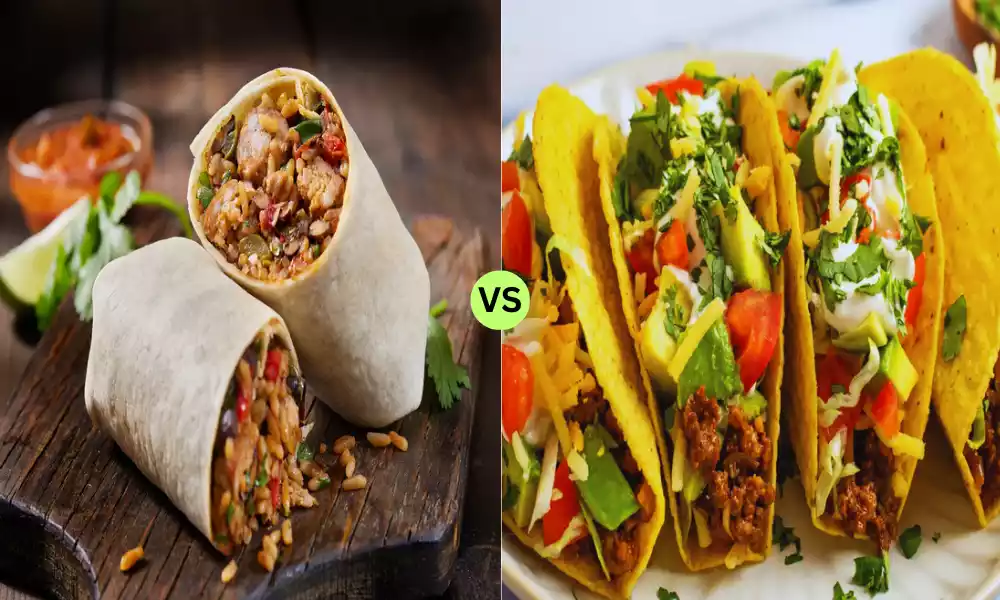Burritos and tacos are staple dishes in Mexican cuisine that have gained worldwide popularity. A burrito is a large, flour tortilla rolled around a generous filling, typically including ingredients like beans, rice, cheese, and meats. Its origins trace back to the Mexican state of Chihuahua.
In contrast, a taco consists of a smaller, soft, or crispy corn tortilla folded around a filling, which may include meats, vegetables, and salsa. Originating from the Mexican silver mines, tacos are known for their simplicity and variety. Both dishes offer a delicious taste of Mexican culinary tradition.
Definition of Burrito
A burrito is a dish in Mexican and Tex-Mex cuisine consisting of a large wheat flour tortilla that is wrapped and folded to enclose a variety of fillings.
These fillings typically include a combination of ingredients such as cooked meat (like beef, chicken, or pork), beans (often refried or black beans), rice, cheese, and various condiments such as salsa, guacamole, and sour cream.
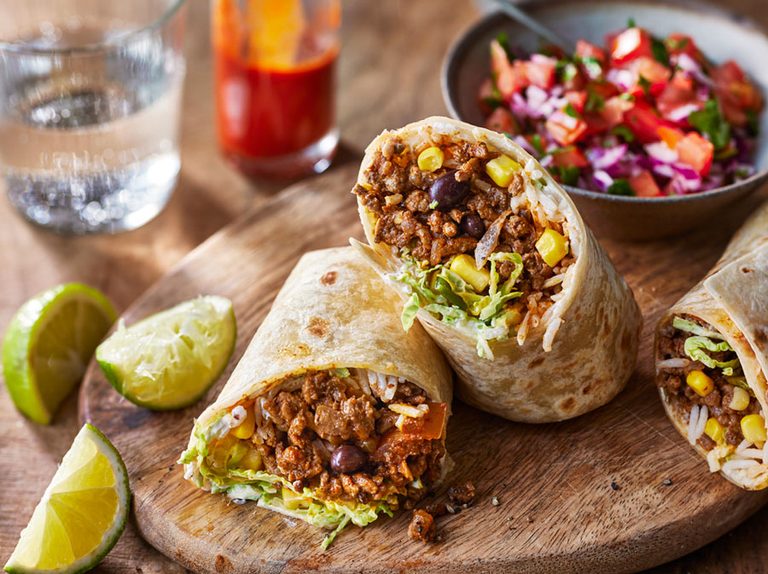
The burrito is known for its portability and versatility, as it can be customized with numerous filling options. The origins of the burrito are believed to be in the Mexican state of Chihuahua, and it has become a popular food item in many countries, particularly in the United States.
How to make a Burrito
Making a burrito involves several steps, from preparing the fillings to wrapping the tortilla.
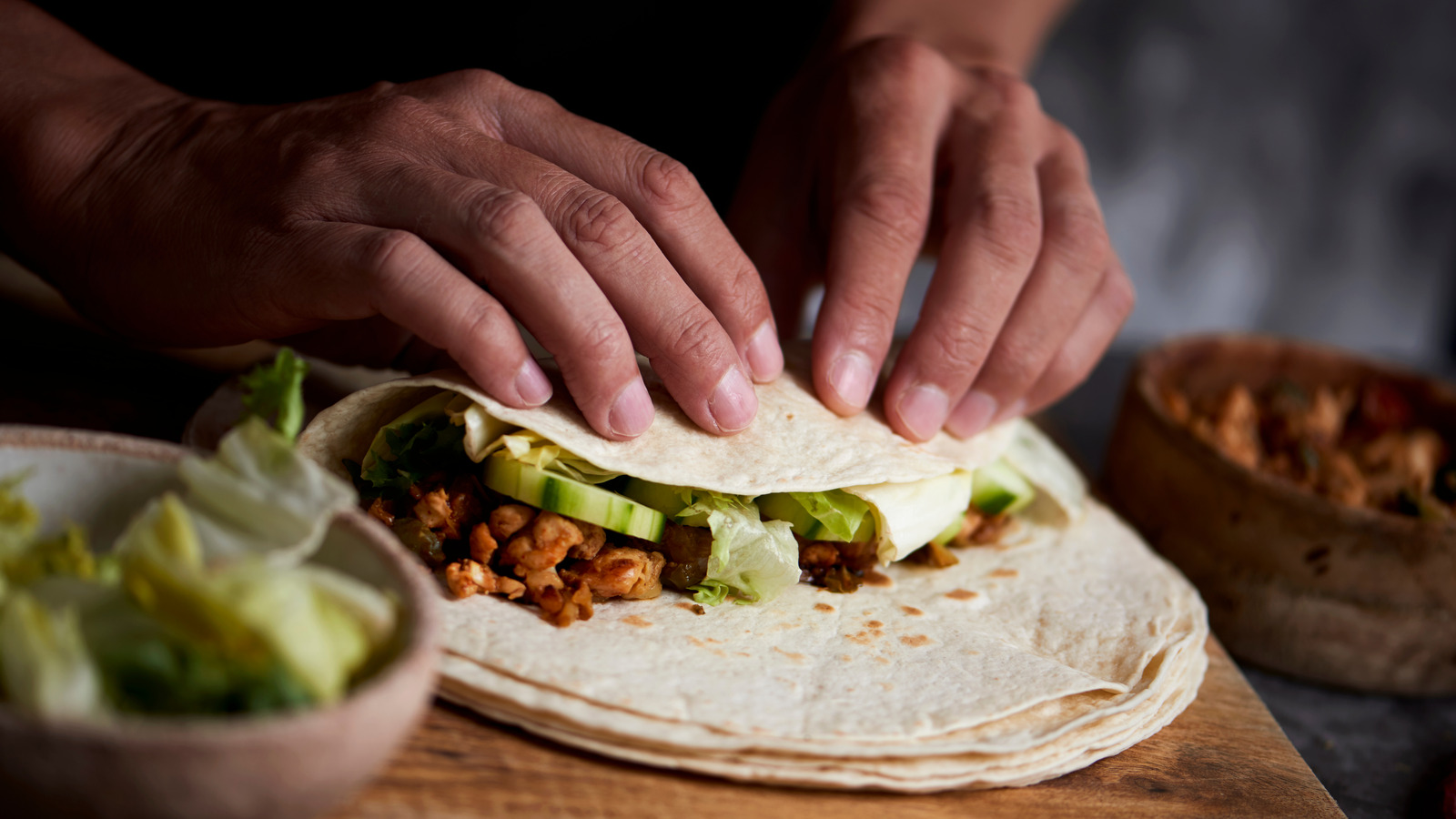
Here’s a simple recipe to begin:
Ingredients
- Large flour tortillas
- Cooked rice
- Cooked beans (black beans or refried beans)
- Protein of choice (e.g., grilled chicken, beef, pork, or tofu)
- Cheese shredded (cheddar, Monterey Jack, or a mix)
- Salsa
- Guacamole
- Sour cream
- Optional extras: sautéed vegetables, lettuce, corn, jalapeños
Instructions
- Prepare the Fillings: Cook your protein (if not already prepared) and season it to taste. The beans should be heated before they are ready to cook the rice. You can also prepare or warm up any additional fillings like sautéed vegetables.
- Warm the Tortillas: Gently warm the tortillas in a skillet or microwave. This makes them more pliable and less likely to tear when wrapping.
- Assemble the Burrito:
- Lay the tortilla flat on a surface.
- Place a scoop of rice in the center of the tortilla.
- Add your choice of protein on top of the rice.
- Add beans, cheese, and any other fillings you desire.
- Top with a spoonful of salsa, guacamole, and sour cream.
- Wrap the Burrito:
- Fold the tortilla’s sides to cover the toppings.
- Hold the sides in place, then roll the burrito from the bottom up, tucking in the fillings as you go.
- Ensure the wrap is tight enough to hold everything together.
- Final Touches (Optional): For a crispy exterior, you can briefly sear the burrito in a hot skillet on all sides.
- Serve: Enjoy your burrito immediately, or wrap it in foil for a portable meal.
Definition of Taco
A taco is a typical Mexican dish made of a tiny hand-sized wheat or corn tortilla that is topped with filling. It is rolled around the filling before being consumed by hand. Tacos can be filled with a variety of ingredients, including beef, pork, chicken, seafood, beans, vegetables, and cheese, allowing for great versatility and variety.
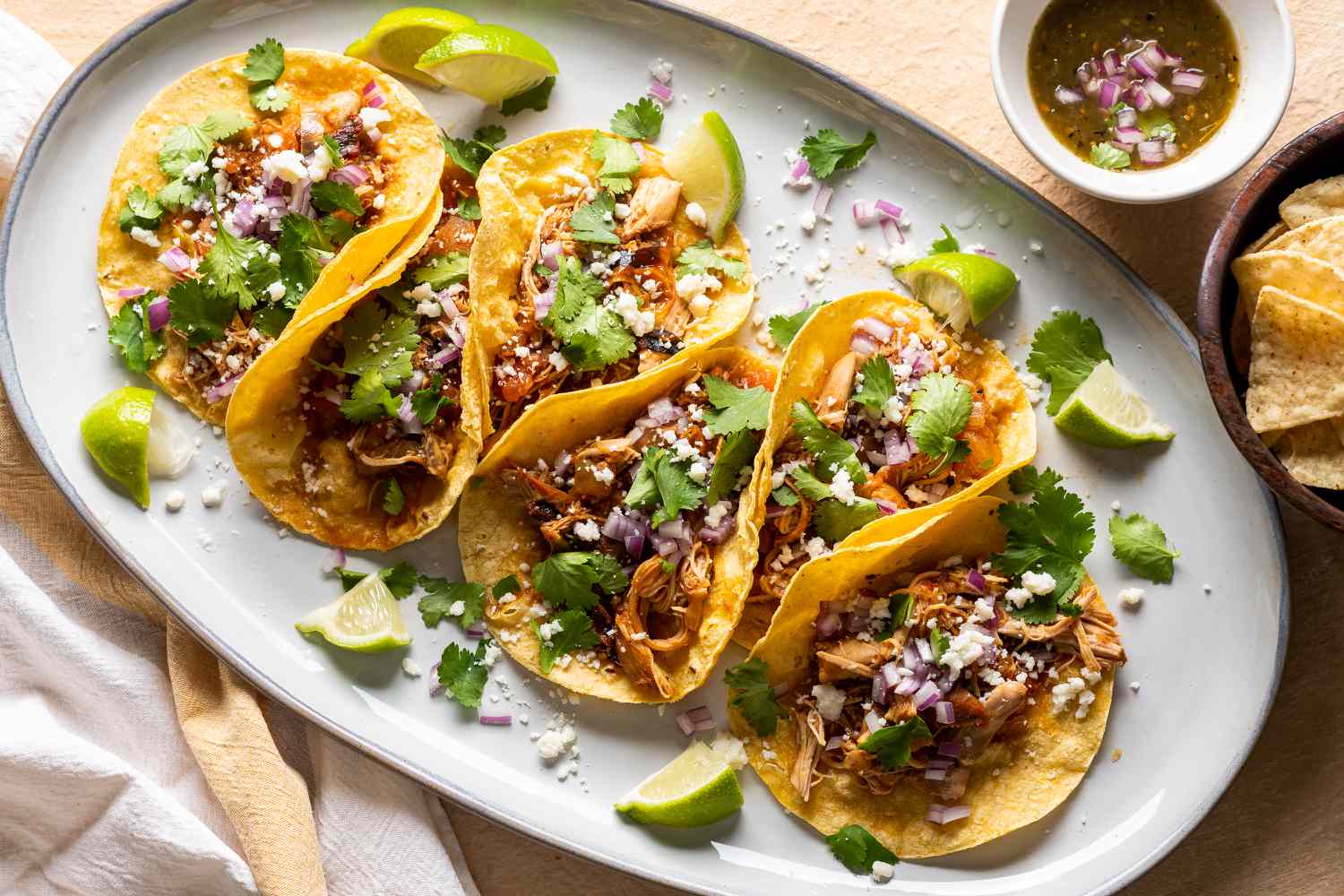
They are often garnished with various condiments, such as salsa, guacamole, or sour cream, and are sometimes accompanied by fresh cilantro, onions, lettuce, or tomatoes.
The taco is known for its simplicity and delicious flavors, originating from Mexico and widely popular around the world. It is a staple of Mexican street food and has been adapted into numerous regional variations in different countries.
How to make Taco
Making tacos is a fun and versatile cooking experience, as they can be customized with a variety of fillings and toppings.
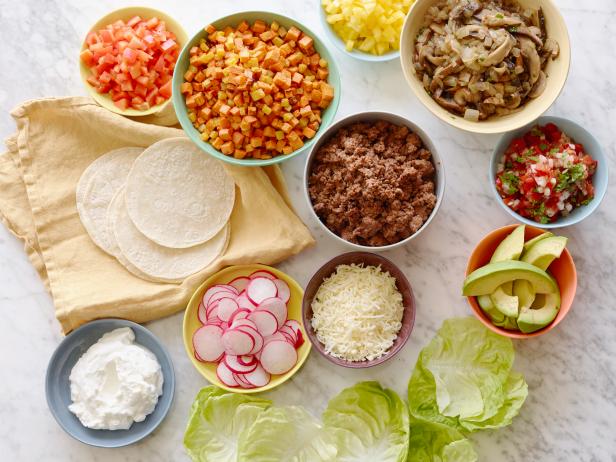
Here’s a basic guide to creating your tacos:
Ingredients
- Corn or flour tortillas (small size)
- Protein of choice (e.g., ground beef, shredded chicken, fish, or a vegetarian option like beans or tofu)
- Toppings:
- Chopped onions
- Diced tomatoes
- Shredded lettuce or cabbage
- Shredded cheese (such as cheddar or Mexican blend)
- Sliced jalapeños (optional for heat)
- Condiments:
- Salsa or pico de gallo
- Sour cream or Greek yogurt
- Guacamole or diced avocado
- Seasonings for the protein (like taco seasoning or a mix of cumin, chili powder, garlic powder, and salt)
Instructions
- Prepare the Protein:
- Cook your protein in a skillet. For ground meat, cook until browned. For chicken, beef strips, or fish, cook until done.
- Season the protein well with taco seasoning or your mix of spices.
- Warm the Tortillas:
- Heat the tortillas in a dry skillet or on an open flame for a few seconds per side until warm and slightly toasted. This makes them more pliable and adds flavor.
- Assemble the Tacos:
- Lay out the tortillas on plates.
- Spoon the cooked protein onto each tortilla.
- Add your chosen toppings: onions, tomatoes, lettuce, cheese, and jalapeños.
- Drizzle with your preferred condiments like salsa, sour cream, and guacamole.
- Serve:
- Tacos are best enjoyed immediately while the tortillas are still warm.
- Accompany with lime wedges for added zest if desired.
Comparison table of Burrito vs Taco
Here’s a comparison table highlighting the key differences between a Burrito and a Taco:
| Feature | Burrito | Taco |
|---|---|---|
| Origin | Mexico, particularly the northern regions like Chihuahua. | Pre-Columbian Mexico, evolved in the 18th century during the silver mining era. |
| Tortilla | Typically uses a large, soft flour tortilla. | Uses smaller corn or wheat tortillas, which can be soft or hard (crispy). |
| Fillings | Often includes a combination of ingredients like beans, rice, cheese, and a variety of meats. | Fillings are more minimal, usually featuring meat or seafood, sometimes with beans, cheese, and vegetables. |
| Serving Size | Generally larger and more filling. Designed as a complete meal. | Smaller, often eaten in multiples for a complete meal. |
| Eating Style | Eaten with hands, but sometimes requires a foil wrap to hold together due to size and amount of filling. | Typically easy to eat by hand, designed to be a few bites. |
| Variations | Variants include California burrito, breakfast burrito, etc. | Includes street tacos, gourmet tacos, fish tacos, etc. |
| Cultural Evolution | Gained considerable variations and size in the United States, especially in Tex-Mex cuisine. | Adapted globally with variations, maintaining more traditional styles in Mexico. |
| Customization | Highly customizable with a wide range of potential ingredients. | Also customizable, though traditionally more focused on the specific type of filling and toppings. |
This table provides a broad overview, but keep in mind that both dishes have regional variations and personal interpretations, which can blur the lines between these general characteristics.
Culinary traditions
The culinary traditions of burritos and tacos, while both rooted in Mexican cuisine, differ significantly in their preparation, presentation, and regional variations.
Burrito
- Northern Mexican Origins: The burrito has its roots in the northern regions of Mexico. Traditionally, it was a simple meal, with a few ingredients like beans and meat wrapped in a wheat flour tortilla.
- Tex-Mex Evolution: When the burrito crossed into the United States, particularly in Texas (Tex-Mex cuisine), it evolved considerably. The Americanized burrito became larger and often included a wider variety of fillings such as rice, beans, various meats, cheese, lettuce, and sour cream.
- Regional Varieties: Within the U.S., different styles emerged. The California burrito, for instance, often includes French fries and avocado or guacamole. The breakfast burrito, filled with eggs and other breakfast items, is another popular variant.
- Preparation: The key to a good burrito is in how it’s assembled and wrapped, ensuring a neat package that holds all ingredients without spilling.
Taco
- Pre-Columbian Roots: Tacos date back to pre-Columbian times and were a staple in the diet of the indigenous people in the Valley of Mexico, originally using corn tortillas to wrap around fish or other fillings.
- Diversity in Fillings: Traditional Mexican tacos often feature grilled or stewed meats, such as carne asada (grilled beef), al pastor (marinated pork), or carnitas (braised pork). Fresh garnishes like cilantro, onions, and a squeeze of lime are common.
- Street Food Tradition: In Mexico, tacos are often served as street food. They are made with soft, small corn tortillas and are meant to be eaten as a snack or a meal, with each taco being a few bites in size.
- Global Adaptation: Globally, tacos have been adapted in countless ways. In the U.S., hard-shell tacos and gourmet-style tacos with a variety of unique ingredients have become popular.
Both burritos and tacos symbolize the adaptability and rich flavors of Mexican cuisine. Burritos represent a fusion and evolution of traditional Mexican and American tastes, growing in size and variety.
Tacos, while also adapted globally, often stay closer to their traditional roots, especially in Mexico, signifying the simplicity and diversity of flavors in Mexican street food.
Similarities between Burrito and Taco
Despite their differences, burritos and tacos share several similarities, reflecting their common roots in Mexican cuisine:
- Mexican Origins: Both dishes originate from Mexico, showcasing the diverse culinary traditions of the region.
- Tortilla-Based: Both burritos and tacos use tortillas as a fundamental component. Burritos typically use large, soft flour tortillas, while tacos use smaller corn or wheat tortillas.
- Customizable Fillings: Both dishes are highly customizable with a variety of fillings, including meats (such as beef, chicken, and pork), beans, cheese, and vegetables. This allows for a wide range of flavors and dietary preferences.
- Popular Street Food: In their traditional forms, both burritos and tacos are popular as street foods in Mexico, known for their convenience and portability.
- Global Popularity: Both have gained immense popularity worldwide, becoming staple dishes in many countries beyond Mexico, especially in the United States.
- Served Warm: Typically, both burritos and tacos are served warm, with the fillings either cooked or heated before being added to the tortilla.
- Condiments and Toppings: They often share common toppings and condiments, such as salsa, guacamole, sour cream, and cheese.
- Handheld Convenience: Both are typically eaten by hand, making them convenient for casual dining and on-the-go meals.
- Cultural Adaptations: Each has undergone various adaptations and transformations in different cultures, leading to unique regional variations and interpretations.
- Social and Family Food: They are often enjoyed in social settings and are popular choices for family meals and gatherings, owing to their versatility and wide appeal.
These similarities highlight how burritos and tacos, while distinct in their specifics, share a common heritage and role in both Mexican and global cuisine.
Dining Experience
The dining experience for burritos and tacos can vary significantly depending on the setting, preparation, and presentation of these dishes. Here’s an overview of what you might expect when enjoying these Mexican staples:
Burrito Dining Experience
- Setting: Burritos can be enjoyed in a range of settings, from fast-casual restaurants and food trucks to more upscale dining establishments offering gourmet versions.
- Presentation: A burrito is typically served as a single, large item, often wrapped in foil or paper for handheld eating. In some restaurants, burritos may be served cut in half, with fillings visible, or smothered with sauce and cheese.
- Eating Style: Burritos are generally eaten with hands, although some overstuffed or sauce-covered versions might require a fork and knife.
- Sensory Experience: The first bite of a burrito is often a mix of flavors and textures – the softness of the tortilla, combined with the warmth and variety of the fillings.
- Satiety: Given their size and the variety of fillings, burritos are often quite filling, making them a satisfying meal option.
Taco Dining Experience
- Setting: Tacos are famous as street food, so a traditional taco experience might be at a street vendor or casual eatery, although they are also served in high-end restaurants.
- Presentation: Tacos are usually served on a plate or at a taco stand, often in multiples since they are smaller. The fillings are visible, and topped with garnishes like salsa, lime, cilantro, and onion.
- Eating Style: Tacos are meant to be eaten with hands. It’s a casual, sometimes messy affair, to enjoy the fresh ingredients and combinations in each bite.
- Sensory Experience: Eating a taco involves enjoying the contrast of textures and flavors – the softness or crunch of the tortilla, the seasoned fillings, the freshness of the toppings, and the zing from lime or salsa.
- Variety: Since tacos are smaller, it’s common to try different types in one meal, making for a diverse and engaging dining experience.
Common Elements
- Social Aspect: Both burritos and tacos are often shared in social settings, making them great for group dining.
- Culinary Adventure: Trying different fillings and toppings can be a culinary adventure, offering a taste of Mexican culture.
- Casual and Fun: Both foods lend themselves to a relaxed and enjoyable eating experience, often encouraging informality and conversation.
The dining experience is as much about the atmosphere and company as it is about the food itself. Whether it’s the hearty satisfaction of a burrito or the varied flavors of tacos, both offer unique and enjoyable culinary experiences.
Popularity Worldwide
The worldwide popularity of burritos and tacos is a testament to the global appeal of Mexican cuisine. Both dishes have transcended their regional origins to become beloved staples in many countries across the globe.
Here’s a look at how each has gained international recognition:
Burrito
- United States: Burritos has become a cornerstone of Tex-Mex cuisine, particularly in states bordering Mexico like California and Texas. Variations like the California burrito and the breakfast burrito have emerged.
- Global Spread: Beyond the U.S., burritos are popular in countries like Canada, the UK, and Australia. They are often adapted to local tastes, incorporating ingredients more familiar to the regional palate.
- Fast Food and Casual Dining: The rise of fast-food and casual dining chains specializing in Mexican cuisine has played a significant role in popularizing burritos worldwide.
- Adaptability: The burrito’s versatility in fillings makes it easily adaptable to different cuisines, contributing to its global popularity.
Taco
- United States: Tacos have a strong presence in the U.S., with both authentic Mexican styles and Americanized versions like the hard-shell taco being widely available.
- Global Reach: Tacos are enjoyed in many countries, and often featured in Mexican restaurants worldwide. The concept of a taco bar or taco night has also become popular in home cooking globally.
- Street Food Culture: The taco’s origins as street food resonate globally, with food trucks and street vendors in various countries offering their takes on this Mexican classic.
- Culinary Experiments: The simplicity of tacos makes them a favorite for culinary experimentation, leading to fusion varieties that blend Mexican flavors with other cuisines.
Common Factors in Global Popularity
- Cultural Exchange: Increased global travel and cultural exchange have introduced a wider audience to Mexican cuisine, including burritos and tacos.
- Media Influence: The portrayal of these dishes in television, movies, and social media has also sparked international interest.
- Dietary Trends: The growing interest in diverse, flavorful, and customizable food options has propelled the popularity of both burritos and tacos.
Summary
Burritos and tacos are both iconic staples of Mexican cuisine, they each offer distinct culinary experiences. Burritos, with their larger, flour tortilla wraps and diverse fillings, provide a hearty and versatile meal, often adapted to various global cuisines.
Tacos, characterized by their smaller, corn or wheat tortillas and simpler fillings, epitomize the classic flavors of Mexican street food and have similarly enjoyed worldwide popularity and adaptation. Both dishes, in their unique ways, have become ambassadors of Mexican culinary tradition on the global stage.

